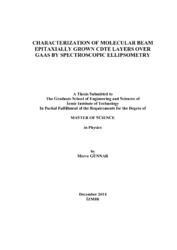Please use this identifier to cite or link to this item:
https://hdl.handle.net/11147/4283Full metadata record
| DC Field | Value | Language |
|---|---|---|
| dc.contributor.advisor | Selamet, Yusuf | en_US |
| dc.contributor.author | Günnar, Merve | - |
| dc.date.accessioned | 2015-05-08T12:29:36Z | |
| dc.date.available | 2015-05-08T12:29:36Z | |
| dc.date.issued | 2014 | |
| dc.identifier.citation | Günnar, M. (2014). Characterization of molecular beam epitaxially crown CdTe layers over GaAs by spectroscopic ellipsometry. Unpublished master's thesis, İzmir Institute of Technology, İzmir, Turkey | en_US |
| dc.identifier.uri | http://hdl.handle.net/11147/4283 | |
| dc.description | Thesis (Master)--Izmir Institute of Technology, Physics, Izmir, 2014 | en_US |
| dc.description | Includes bibliographical references (leaves: 93-98) | en_US |
| dc.description | Text in English; Abstract: Turkish and English | en_US |
| dc.description | xiv, 98 leaves | en_US |
| dc.description.abstract | The infrared detectors consist of two main parts that are optical elements and sensing elements. The sensor component is generally formed by semiconductor materials that can detect Infrared (IR) light which cannot be seen by human eye. Mercury Cadmium Telluride (MCT, HgCdTe) is widely used as a sensor material for this purpose. The adjustable bandgap (0-1.5 eV) which corresponds to energies of IR light can be obtained by changing the composition x of cadmium (Cd) in the ternary alloy Hg1-xCdxTe. HgCdTe has very high quantum efficiency for the detectible IR wavelengths in the atmospheric windows. HgCdTe which has a great importance in defense industry as an IR detecting material should be grown with high crystallinity in order to obtain high resolution images even under bad weather conditions. In addition, HgCdTe must be grown uniformly over a large area in order to have large format and high operability focal plane arrays. The defect density of HgCdTe strongly depends on the lattice mismatch between substrate and HgCdTe. In order to reduce the lattice mismatch which causes dislocations in HgCdTe the best suitable option is to grow Cadmium Telluride (CdTe) buffer layer on a substrate before growing HgCdTe. Studies have been focusing on semiconductors which are Gallium Arsenide (GaAs), Silicon (Si) and Germanium (Ge) as alternative substrates for CdTe growth. In this study, the CdTe films grown on (211) oriented GaAs wafers by molecular beam epitaxy (MBE) were characterized by ex-situ spectroscopic ellipsometry (SE). The properties of CdTe films such as thickness, surface roughness and optical constants were characterized by comparison with the growth conditions. It was also investigated that how these properties vary over the film surface. Characterization results were compared to those obtained by atomic force microscopy (AFM), Nomarski microscopy, Fourier transformation infrared spectroscopy (FTIR) and X-ray diffraction (XRD). The temperature dependencies of the optical properties of the material obtained by SE were also investigated. | en_US |
| dc.language.iso | en | en_US |
| dc.publisher | Izmir Institute of Technology | en_US |
| dc.rights | info:eu-repo/semantics/openAccess | en_US |
| dc.subject | Ellipsometry | en_US |
| dc.subject | CdTe films | en_US |
| dc.subject | Molecular beam epitaxially | en_US |
| dc.title | Characterization of molecular beam epitaxially crown CdTe layers over GaAs by spectroscopic ellipsometry | en_US |
| dc.title.alternative | Moleküler demet epitaksi ile GaAs üzerine büyütülen CdTe katmanlarının spektroskopik elipsometri ile karakterizasyonu | en_US |
| dc.type | Master Thesis | en_US |
| dc.institutionauthor | Günnar, Merve | - |
| dc.department | Thesis (Master)--İzmir Institute of Technology, Physics | en_US |
| dc.relation.publicationcategory | Tez | en_US |
| item.languageiso639-1 | en | - |
| item.fulltext | With Fulltext | - |
| item.openairecristype | http://purl.org/coar/resource_type/c_18cf | - |
| item.openairetype | Master Thesis | - |
| item.grantfulltext | open | - |
| item.cerifentitytype | Publications | - |
| Appears in Collections: | Master Degree / Yüksek Lisans Tezleri | |
Files in This Item:
| File | Description | Size | Format | |
|---|---|---|---|---|
| T001306.pdf | MasterThesis | 7.37 MB | Adobe PDF |  View/Open |
CORE Recommender
Page view(s)
100
checked on Jul 22, 2024
Download(s)
178
checked on Jul 22, 2024
Google ScholarTM
Check
Items in GCRIS Repository are protected by copyright, with all rights reserved, unless otherwise indicated.